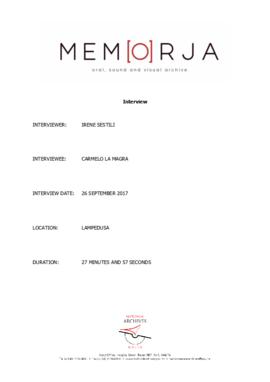Knights of Malta
7 Archival description results for Knights of Malta
Giovanni Fragapane continued to trace the relations between Lampedusa and the Knights of Malta. He described the origin of the Maltese colony in Lampedusa from 1800 to 1843 and its impact on the Island.
In the first part of the interview, Giovanni Fragapane explained his research and the sources he used to write his book about the history of Lampedusa. He traced the relations between Lampedusa and the Knights of Malta. He described the origin of the Maltese colony in Lampedusa from 1800 to 1843 and its impact on the Island.
Dates covered: 1800-2017. Giovanni Fragapane is considered the historian of Lampedusa. He started the interview with an explanation of his research, the sources he used and the history of Lampedusa. He traced the relations between Lampedusa and the Knights of Malta. He described the origin of the Maltese colony in Lampedusa from 1800 to 1843 and its impact on the Island. In the second part of the interview, he focused on his experiences and memories about Malta. He described the conference for peace in the Mediterranean after the Gaddafi crisis and the Mintoff period. The last part of the interview focuses on the history of the Sanctuary of Our Lady of Lampedusa, the history of the statue and the religious feast.
The interview started with a short introduction about Carmelo La Magra's childhood and background. The focus shifted to the religious feast of Our Lady of Lampedusa: symbolism, procession, relations between church and mayor (secular authority), organisation, etc. In the last part of the interview, La Magra described the history of the Sanctuary and its symbolic place on the Island: a place of refuge, freedom, safety and a place where Islam and Catholicism coexisted peacefully for centuries.
The interview started with a short introduction about Carmelo La Magra's childhood and background. The focus shifted to the religious feast of Our Lady of Lampedusa: symbolism, procession, relations between church and mayor (secular authority), organisation, etc. In the last part of the interview, La Magra described the history of the Sanctuary and its symbolic place on the island: a place of refuge, freedom, safety and a place where Islam and Catholicism coexisted peacefully for centuries.

